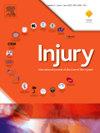Can trauma scores predict the length of hospital stay of patients with fractures after earthquake-related blunt injury?
IF 2.2
3区 医学
Q3 CRITICAL CARE MEDICINE
Injury-International Journal of the Care of the Injured
Pub Date : 2024-11-21
DOI:10.1016/j.injury.2024.112041
引用次数: 0
Abstract
Objective
The number of patients during disastrous conditions was high, and triage is essential. In chaotic circumstances, orthopedic surgeons can also struggle with patient selection, not only for surgical selection but also for the necessity of hospitalization. So, the performance of the Injury Severity Score, New Injury Severity Score, and Trauma and Injury Severity Score was compared in victims who were struck under the wreckage and had fractures due to the Kahramanmaras Earthquake.
Material and Methods
The study included 147 patients. Patients younger than 18, lacking information that prevents calculation of trauma scores, having a history of fracture other than struck injury, and those who didn't survive the follow up were not included in the study. Fractures were classified as anatomic regions. The relationship between the trauma scores, fracture regions, entrapment durations, and length of hospital stay was evaluated. Other risk factors related to length of stay were also determined.
Results
The age and gender of the patients did not affect the length of hospital stay. There was no relationship between the fracture region and length of stay. Even the proximal fractures of the upper extremities had significantly shorter hospitalization duration. Entrapment duration was correlated considerably with length of stay (p < 0.001). NISS, ISS, and NISS were correlated with length of stay (p < 0.001, p < 0.001, p = 0.033), and the AUC values of the trauma scores were 0.70, 0.66, and 0.59, respectively. Multiple regression analysis showed that only NISS and entrapment duration was related to length of stay, while ISS and TRISS were not.
Conclusion
All the trauma scores can assess expected length of hospital stay for patients with fractures; however, NISS shows better predicting performance. Additionally, the fracture location is not associated with the length of stay.
创伤评分能否预测地震钝性骨折患者的住院时间?
目的危重病人数量多,分诊至关重要。在混乱的情况下,骨科医生也会在病人选择上挣扎,不仅是手术选择,还有住院的必要性。因此,在Kahramanmaras地震中,受伤严重程度评分,新受伤严重程度评分,以及创伤和伤害严重程度评分的表现进行了比较。材料与方法纳入147例患者。年龄小于18岁的患者,缺乏信息无法计算创伤评分,有除撞击伤以外的骨折史,以及那些在随访中未能存活的患者不包括在研究中。骨折按解剖区域分类。评估创伤评分、骨折区域、夹持时间和住院时间之间的关系。与停留时间有关的其他风险因素也被确定。结果患者的年龄和性别对住院时间没有影响。骨折区域与住院时间没有关系。即使是上肢近端骨折,住院时间也明显缩短。滞留时间与停留时间显著相关(p <;0.001)。NISS、ISS和NISS与住院时间相关(p <;0.001, p <;0.001, p = 0.033),创伤评分的AUC值分别为0.70、0.66、0.59。多元回归分析显示,只有NISS和滞留时间与住院时间有关,ISS和TRISS与住院时间无关。结论所有创伤评分均能评价骨折患者的预期住院时间;然而,NISS显示出更好的预测性能。此外,骨折位置与住院时间无关。
本文章由计算机程序翻译,如有差异,请以英文原文为准。
求助全文
约1分钟内获得全文
求助全文
来源期刊
CiteScore
4.00
自引率
8.00%
发文量
699
审稿时长
96 days
期刊介绍:
Injury was founded in 1969 and is an international journal dealing with all aspects of trauma care and accident surgery. Our primary aim is to facilitate the exchange of ideas, techniques and information among all members of the trauma team.

 求助内容:
求助内容: 应助结果提醒方式:
应助结果提醒方式:


